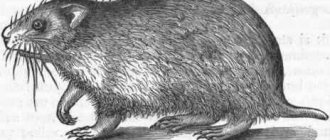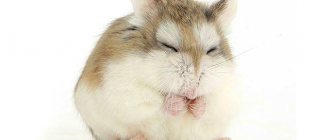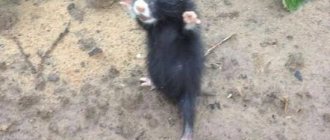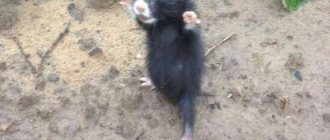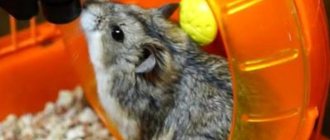The steppe hamster (common) is a large self-spreading rodent species that has virtually nothing in common with domestic pets. It is distinguished by small ears, well-developed toes, and is excellent at digging holes and doing other things. But the most important thing is that he is able to live independently; he not only does not need human help, the hamster will aggressively accept it. Sometimes it is much safer to meet a snake or a poisonous spider than this wild and vicious rodent.
Description of the species
You can see quite a lot of features at one glance at such a rodent as the steppe hamster. The description of its appearance is as follows:
- stocky body with a thick head and short neck;
- small ears, shiny and relatively huge eyes;
- short paws with well-developed toes and short claws.
The fur of this animal includes two elements: the base and the undercoat. Thanks to the latter, the hamster can easily endure winters and sub-zero temperatures. The color is usually light yellow or brown. Dark and black spots are common.
A characteristic feature is that hamsters have white feet. But the front and hind limbs are black on the inside.
But this does not mean that you will not be able to meet a steppe hamster, which will have a completely different color. Sometimes you can see completely white or, on the contrary, completely black representatives of the family.
Separately, it is necessary to say about the sizes. Males reach a length of 34 cm excluding the tail. The latter can reach up to 5 cm in length.
Option 2
When you mention a hamster, a person imagines a cute little domestic creature, but in fact, in its habitat, the animal is not as simple and harmless as it seems.
Even in Ancient Assyria, children played with the Syrian mouse, which became the progenitor of hamsters.
A representative of the rodent order, the hamster has a small body, the length of which, depending on the species, ranges from 5 cm to 34 cm, with short ears and a tail. Females are usually larger than males. The weight of an adult animal is about 600 grams. Developed cheek pouches are a distinctive feature of rodents. Hamsters vary in color from gray to dark brown on the back, and from white to black on the belly. The animal's teeth are strong and sharp, they are renewed throughout the hamster's life.
The habitat of hamsters is quite common: eastern and central European parts, Syria, Asia Minor, northern China, Korea, Siberia. They live in deserts, semi-deserts, fields, gardens; some species can be found in the mountains at an altitude of up to 3500m. The main thing for a rodent is the availability of food supply. They feed on plant and animal food, but the basis of their diet is plant seeds, so they often dig their burrows right in the fields.
The hamster is a thrifty animal; its storage reaches a width of up to 7 m. up to 2 m deep. Accumulations are hundreds of times greater than the weight of the animal itself. The hamster's thrifty cheek pouches can hold up to 50 grams. stern. In some areas, an invasion of crops by hamsters is considered a natural disaster. The rodents themselves are prey for ferrets, foxes, badgers, and birds of prey.
The hamster is a solitary animal, jealously guarding its territory. There are cases of them attacking large dogs, and steppe hamsters can attack humans; these bites are dangerous, as they can cause infection and lead to serious illnesses.
The skins of some species of hamsters are harvested; the animal is mainly used in laboratory research and as a pet. Two species of hamster (Syrian and Newton's) are listed in the International Red Book.
The life expectancy of hamsters is not long in captivity - up to 3 years, at home - up to 5 years. Hamsters are very prolific, producing offspring several times a year. From 5 to 15 cubs can appear at one time. The babies appear bald, blind, but already have teeth. On the 3rd day the fluff appears, on the 7th day the eyes open.
In biology, hamsters are divided into 19 species, comprising 7 genera. Russia is home to 12 species of rodents from 6 genera: gray, medium, rat-like, magnopaed, Eversmann's, and true.
Djungarian and Syrian hamsters are usually kept at home; the latter have a variety of colors and long hair. The hamster should live alone in the cage. To cross individuals, they use a neutral territory, connecting a female with a male only on a certain day. Born babies are separated from their mother for 4 weeks; they can be given away at 5 weeks.
When they arrive at the age of 1.5 months, hamsters get used to people and do not show aggression. They love to play, are not afraid of hands and quickly become family favorites.
Distribution area
The steppe hamster is distributed over quite wide areas. It lives in lands from Europe to China. In particular, in Russia it can be found in the open spaces from Smolensk to the southern taiga.
This hamster does not require any special living conditions, which is why it can live virtually anywhere. For the most part, animals are found near grain and wheat fields. Some individuals dig their burrows directly on these arable lands. The rest prefer to live closer to people. They settle near villages and hamlets. The food consists of various products from the garden.
It is not uncommon for hamsters to visit barns and storerooms. Like house mice, they carry supplies into their burrows. But, unlike them, hamsters are much more dangerous, as they are aggressive against humans. Therefore, it is necessary to set traps if such a “neighborhood” is suddenly noticed.
Habitat
The wild hamster is distributed almost everywhere. The habitat of the carbysh covers the Caucasus, Siberia, Altai and the Crimean Peninsula. The hamster is found in Kazakhstan, China and many European countries.
Previously, the animal lived in the steppe, forest-steppe and mixed-grass meadows. But due to large-scale deforestation, the rodent's distribution area has expanded significantly. The wild hamster successfully colonizes gardens, fields, orchards and summer cottages. And if there is a lack of food, the animal can settle in living quarters.
On a note. A wild hamster alone is capable of destroying the lion's share of the crop. Therefore, in dachas you need to pay attention to signs of the presence of a pest. The steppe rodent leaves characteristic marks, digs at the roots of carrots and potatoes, and also eats the bark at the very bottom of trees.
Hamster hole
The steppe hamster spends most of its life in a burrow. This is not at all due to the fact that he is afraid to leave the confines of his home. The animal is quite fearless. But to hunt, he needs a lot of rest.
The hamster hole goes 1-2 meters deep into the earth. It all depends on how easy it is to dig the soil. The basis of the house consists of:
- living chamber;
- inclined exit;
- steep entrance.
The living chamber, in turn, has three “doors”. The first two are intended to ensure that the animal can freely enter home and leave if necessary. And the third door is oriented to the room with supplies. Only in winter and early spring does the hamster use products from there; on other days its diet consists of fresh grains, vegetables and fruits.
How to identify a hamster? You can do this based on characteristic buildings. They are easily recognized by small piles of earth located directly near the inlet/outlet. They are sprinkled with grain husks on top.
Using a small stick, you can find out whether a rodent lives in the found hole. It needs to be placed inside and then pulled out. If cobwebs, moss, husks or grass are found on it, then the dwelling is abandoned. No hamster would keep his house in disarray.
Interesting answers
- Nettle - message report (grades 2, 3, 4)
Nettle is known to be beneficial and irritate the skin when touched. Nettle is a perennial green plant that grows up to 1.2 m in height, and the bush grows up to 1 m in width. It grows like a weed and is not picky about climate and care. - Mica is a mineral (report message 2, 3, 4 class the world around us. Geography)
Mica is one of the most common minerals. But despite this, the upper layers of the earth’s crust contain no more than 4 percent. - The story of Fedya in the story of Bezhin Lug Turgenev
This is how he showed his upbringing (He believed that this is how children from rich families should behave) - The life and work of Evgeny Schwartz
Evgeny Lvovich Schwartz (1896-1958) is an outstanding Soviet playwright, prose writer, and screenwriter, whose creative work includes more than twenty-five plays. - The Life and Work of Carlo Gozzi
Carlo Gozzi (1720-1806) is a famous Italian playwright and writer, from whose pen a large number of fairy-tale plays, called fiabs, based on folklore elements of the storyline came out
Feeding the steppe hamster
What does a hamster eat? It is impossible to specify this moment in any way. Everything directly depends on the place where he lives. If its habitat is focused on places near grain fields, then it will feed mostly on grain crops. At the same time, its harm to agriculture will be minimal. Moreover, often during their trips for supplies, hamsters eat small insects and animals, which makes it easier for humans to get rid of them.
If the animal has settled near a village, then the basis of its diet will be vegetables and those crops that are most popular in the region. But they cannot be collected as supplies for the winter, so hamsters have to destroy people's warehouses and barns to find grains.
It is not uncommon for hungry animals to attack chickens, especially if there is no chicken nearby to protect them or at least make some noise.
Lifestyle
It is most numerous in the forest-steppe, forb and grass-forb steppe. It penetrates into the forest zone through floodplain and dry meadows, as well as forest fields (secondary deforested and plowed areas). In the south of the range it adheres to wet areas: river valleys, depressions. It rises into the mountains to the lower border of the forest, and if there is no forest belt, to the mountain meadows inclusive. It settles in cultivated areas - in rice systems, forest belts, parks, gardens, vegetable gardens and even in residential buildings. It settles less frequently on sandy and loose areas than on dense soils.
Twilight lifestyle. Spends the day in a hole, usually deep and complex, reaching 8 m in length and more than 1.5 m in depth. Sometimes it occupies gopher burrows. A permanent burrow has 2-5, rarely up to 10 exits, a nesting chamber and several storage rooms. Outside the breeding season, the common hamster leads a solitary lifestyle, is aggressive towards its relatives and is pugnacious.
Nutrition
The hamster is omnivorous, but its diet is dominated by plant foods. In addition to them, it eats insects and their larvae, small vertebrates (mice, reptiles and amphibians). By autumn, it completely switches to feeding on seeds and tubers, which it stores in significant quantities: from 0.5 to 11-16 kg. Hamster pantries are known to contain stocks of grain or potatoes up to 90 kg. The hamster feeds on them in the winter, when he temporarily wakes up from hibernation, and also in the spring before fresh food becomes available.
The hamster carries food in its cheek pouches, sometimes more than a kilometer away. Its cheek pouches can hold up to 46 g of wheat. In the storerooms they found selected dried grains (rarely whole ears), peas, rice, millet, buckwheat, lupine, corn, lentils, and potatoes. The hamster stores different types of seeds separately.
> Life cycle
The common hamster lives up to 4 years in the wild, and 3-6 years in captivity.
Hibernation
A wild hamster is susceptible to hibernation, since it has no other option other than a slow metabolism to endure harsh weather conditions. He begins to wake up when the earth freezes. This usually happens in February, sometimes a little later.
A notable feature is that the hamster will not immediately open its entrances and exits. First, he will sit in the hole for some time, eating up the remaining supplies, and only after a month the holes will be open.
Females come out later, closer to mating time.
First, after hibernation, animals begin to eat seeds and grains that they find in the fields. Then they proceed to the young shoots. But at any time after hibernation, hamsters are ready to feast on meat. They will not hunt on their own; their diet will be varied only if they encounter a weak or wounded animal along the way.
Character
The hamster is the most aggressive and evil rodent. If other species of its family prefer not to appear in front of humans, then this one will rush into battle at the first opportunity. Moreover, these animals rush at dogs that are several times larger than themselves.
Even if you look at what a hamster eats, you can immediately recognize its evil character. For example, if a male meets a female not during mating, he will bite her to death. If, during the mating process itself, several contenders line up for the process, then the weaker ones rarely manage to survive.
It is impossible not to note the love of animals for territorial division. Males can control land up to 12 hectares, females - a little less. If another animal enters the territory of one hamster, a fight ensues. Moreover, the owner of the land will defend himself as zealously as possible.
Thus, a meeting with a steppe hamster does not bode well. The only way to make a good pet out of him is to bring a very small individual into the house, which will not know how its relatives live.
Is it a protected animal?
In recent years, the hamster population has declined sharply. Scientists attribute this to a decrease in female fertility. Previously, the litter consisted of 10-12 cubs. Now their number has decreased to 3-6 individuals. This is due to the active use of pesticides by humans in agriculture.
Until the middle of the 20th century. In Europe and the USSR, animals were hunted for their fur. Massive fishing and the active use of pesticides in agriculture have also led to a reduction in the number of rodents.
In some European countries, the wild hamster is on the verge of extinction. In France, Belgium, Poland, and Germany, rodents are protected. Measures are being taken to restore the animal population. A decrease in the number of rodents has been recorded in Russia. In 5 constituent entities of the Russian Federation, the hamster received conservation status. Animals are protected in Tatarstan, Tambov, Nizhny Novgorod, Penza and Lipetsk regions.
In some countries the hamster is on the verge of extinction.
Reproduction of hamsters
At the end of May, when 4-5 weeks have passed since mating, the female goes to her nest. There, 6-18 cubs can be born. At first the babies will be bald and blind, but each of them already has teeth. Children grow quickly, literally on the 3rd day the first fluff appears. After a week, they open their eyes and slowly crawl around the nest, getting used to exploring the world.
The steppe hamster shows its loyalty only during mating and raising offspring. Males guard several territories of females. This is done so that in case of defeat in a fight with an enemy, there is an opportunity to continue the race with another female. Mothers treat their babies lovingly. Moreover, they will even accept other cubs for feeding, regardless of their age. But kids may have a negative attitude towards new neighbors. If the decoy child is smaller, he will most likely be run over.
Catching steppe hamsters
Steppe hamsters reproduce quickly in nature. They cannot be called an endangered species, although in many reserves their life is strictly protected. For this reason, some regions of Russia are engaged in “hamster” fishing.
Animals are caught in spring and autumn. This is done until molting occurs. Moreover, if during fights, which is often observed among hamsters, the skin was damaged, then the animal is released into the wild.
Animals are caught in special traps. They are installed next to the hole, digging in a little. Such devices may slightly damage the limbs, but not the skin. After setting the trap, water is poured into the hole. The animal can only be saved if it went for supplies at that time.
The skins are used in the clothing industry. Some hunters eat meat that is said to resemble squirrel. It is considered very tasty, and most importantly – nutritious.
Interesting facts from the life of steppe hamsters
There is no more unique animal than the steppe hamster. Interesting facts from the life of this rodent are often found. For example, biologists were very surprised by their great love and ability to swim. In the process, the animal inflates the bags that are located in the cheeks (where it also places supplies), and floats freely.
When talking about what a hamster eats, one cannot lose sight of its poaching activities. There have been cases when these animals attacked rabbits listed in the Red Book, gnawed their necks and calmly feasted on the meat.
Because hamsters are very aggressive, they have many enemies. And this is good for the person. The fact is that if you do not engage in extermination, which birds of prey are excellent at, the population will become too large. But on some lands, people have to work independently in order to clear the territories.
In conclusion, it must be said that there are many features that a hamster has. The steppes and forest-steppe territories received an excellent unique inhabitant, despite all his aggressiveness and viciousness.
Are there fundamental differences between wild and domesticated individuals?
Domestic and wild rodents have similar body structures, but the animals differ greatly in size. Karbysh is much larger and heavier. The ears of wild species are more massive and clearly visible on the head. The color of the animals is also different; pets often have a beige, golden or white coat. In wild relatives, the body is covered with brown fur with large black and light spots.
The nature of the animals also varies greatly. Pets are calm, peaceful animals. They get used to the presence of a person and allow themselves to be picked up.
Wild individuals are unpredictable and aggressive. They do not tolerate proximity to other animals. A field hamster can bite a person; picking it up is dangerous. This is a wild animal that is very difficult to tame.
